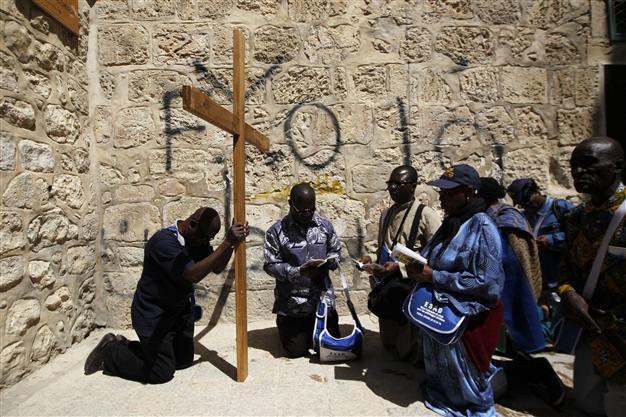Pilgrims fill Jerusalem for Good Friday
JERUSALEM - Agence France-Presse

Christian tourists pray outside the Church of the Holy Sepulchre on Good Friday in Jerusalem's Old City April 6, 2012. REUTERS photo
Christians and Jews in the Holy Land were set to begin marking their most important festivals of the year on Friday, with Good Friday and the Jewish holiday of Passover coinciding.
Jewish families were completing last-minute preparations for Passover, which begins at sundown and commemorate the Israelite's exodus from slavery in Egypt, receipt of the Torah at Mount Sinai and eventual journey into the Promised Land. At a festive dinner called a Seder, unleavened bread is consumed during the seven-day holiday to re-live the hasty flight from Egypt, during which there was no time to allow the bread to rise.
Meanwhile, thousands of Roman Catholics and Protestants were packed into the narrow alleys of Jerusalem's Old City in processions marking the crucifixion and burial of Jesus.
Orthodox Christians will celebrate Easter next Sunday after hold the Holy Fire ceremony in the Church of the Holy Sepulchre the previous day.
Christian pilgrims mark Good Friday every year by walking from the Franciscan Monastery of the Flagellation along the path where Jesus walked, now known as the "Via Dolorosa" or the "Way of Suffering." Sombre pilgrims, some carrying small crosses, others dragging or carrying full-sized ones, were largely silent as they walked in the procession known as the Stations of the Cross.
At each of 13 stops along the way that depict various incidents that occurred between the time Jesus was condemned to death until his burial, they would break into song, mostly in Arabic.
As the procession wound through the Old City's main market, a group of Sri Lankan women wearing bright colours stopped for a quick break in a shop selling gold jewellery.
"This is a very special day when my Jesus died," said Shamli Nonis, who works for an Israeli family as a care giver. "It is a very sad day for us." Hundreds of Israeli police and border police carefully watched over the processions under the blazing sun.
Ahead of the holidays, the Israeli military imposed a two-day closure on the West Bank, saying it would only allow Palestinians access into Israel for emergency medical or humanitarian reasons.
At the same time, the army granted entry permits to 500 Christians living in the Gaza Strip for Israel and the West Bank, and allowed 20,000 Christians living in the West Bank to enter Israel over Easter, a statement from the military read.
According to Gospel accounts, Jesus, a Jew, was betrayed just hours after eating the traditional Passover meal with his disciples at a house in Jerusalem.
Hours later, he was condemned to death and forced to carry his cross to the crucifixion site on a hill outside the city, known as Golgotha, or "place of the skull" in Aramaic.
The Gospels say Jesus rose from the dead on the morning of what has become known as Easter Sunday -- the most important day of the year for Christians.
Friday's march ends at the Church of the Holy Sepulchre in the middle of the Old City, an ancient sprawling shrine which tradition says was built on the original site of the crucifixion, burial and resurrection.
Other quiet remembrance ceremonies were to take place at the nearby Garden Tomb, an alternative site outside the Old City walls which some believe is the true site of the crucifixion.
Known as Gordon's Calvary after the British general who discovered it in 1894, the site houses a rock-cut tomb and a hillside that looks like a skull, believed to be Golgotha.
